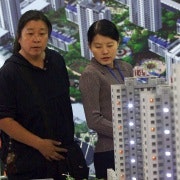Open for business, up to a point
Since Tony Abbott declared “Australia open for business” last October, the government has pushed hard to make Australia attractive to Chinese investors. Abbott, who markets himself as the “infrastructure Prime Minister” raised the prospect of China investing heavily in Australian infrastructure with Chinese Premier Li Keqiang during his visit to China in April.
A Free Trade Agreement (FTA) with China, which the government hopes to conclude before November, will likely raise the foreign review screening threshold for private Chinese investors from $248 million to over $1 billion. Trade Minister Andrew Robb has also openly mentioned the possibility of relaxed investment rules, under an FTA, for state-owned investors that have a strong track record in Australia.
But despite support for Chinese foreign direct investment (FDI) at the highest political levels, Chinese FDI remains unpopular among Australians. Some 56 per cent of Australians feel the country is “allowing too much investment from China”, according to the 2014 Lowy Institute Poll. This number has been almost identical in every Lowy Institute Poll since 2010.
This should concern a government that wants to attract investment from China, particularly at a time when global competition for Chinese investment is growing. In 2013, Chinese investment flows into Australia decreased for the first time since 2009, while Chinese investment globally grew at between 9 and 17 per cent in 2013 (depending on which statistics are used). Investment flows are inherently volatile. A one-year downturn does not make a trend, but the assumption that Chinese FDI into Australia will continually grow as overall Chinese outward investment grows is a dangerous one.
While it’s true that decisions on foreign investment are not made by popular opinion, community sentiment does matter. There have been reports that Chinese investors have been cautious about agribusiness investments due to the public debate in Australia. Popular opposition to investment can also leave the suspicion that any decision to block an investment may be done for populist reasons, regardless of the reality.
The Lowy Poll does not distil why a majority of Australians think too much FDI comes from China. However, in this author’s opinion a number of misperceptions about Chinese investment in Australia seem to colour public thinking.
First, the perceived amount of Chinese investment is probably bigger than it actually is. Overall Chinese investment in Australia remains small. It accounts for only three per cent of total FDI in Australia, ranking it ninth by country.
Second, there is a general aversion towards FDI in Australia, particularly in the industries publicly associated with Chinese investment. The 2014 poll results indicate that 60 per cent of respondents were against the government allowing foreign companies from any country to invest in agriculture, or ports and airports. About half of respondents also opposed investment in Qantas, the NBN and resources.
Much of the opposition to Chinese investment in Australia has focused on agricultural and resource investments, which are both unpopular more broadly as investment industries. In reality, agriculture and agribusiness occupy a very small amount of total Chinese investment in Australia. According to a recent KPMG report on Chinese investment, agribusiness accounted for only one per cent of Chinese investment in 2013. Another KPMG agribusiness report indicated that agriculture accounted for two per cent (in terms of value) of total cumulative Chinese investment in Australia from 2006 to 2012.
Perceptions that much of Chinese investment has gone into mining and gas are correct (over 90 per cent from 2006-2012) but this is part of a small Chinese investment footprint overall. Additionally, the makeup of Chinese investment is changing. In 2013, 40 per cent of Chinese FDI in Australia went into power transmission, 24 per cent mining and 21 per cent gas. There has also been a trend towards more private investment and smaller projects.
Third, concerns surrounding residential real estate investment sometimes get conflated with business investment. In the past year complaints have reached fever pitch that Chinese investors are buying significant amounts of residential real estate and thus driving housing prices up. Whether this is true or not, it should be treated as a separate issue to business investment, and it isn’t clear the Australian public is making that distinction at the moment.
It is important to get the facts of Chinese investment on the table to overcome concerns specific to Chinese investment. But there is a bigger issue in the FDI debate. FDI, including Chinese investment, has benefits for the economy. As Tony Abbott has said himself, foreign investment helped build this nation. Majority opposition to any amount of foreign investment in a number of industries, as indicated in the Lowy Institute Poll, shows that the positive elements of the FDI debate are not resonating with the Australian public.
A more nuanced and open discourse on the positives and negatives of Chinese FDI may help elicit support for the investment component of Abbott’s “open for business” message.
Dirk van der Kley is a Research Associate at the Lowy Institute for International Policy. The 2014 Lowy Institute Poll can be downloaded at www.lowyinstitute.org
















